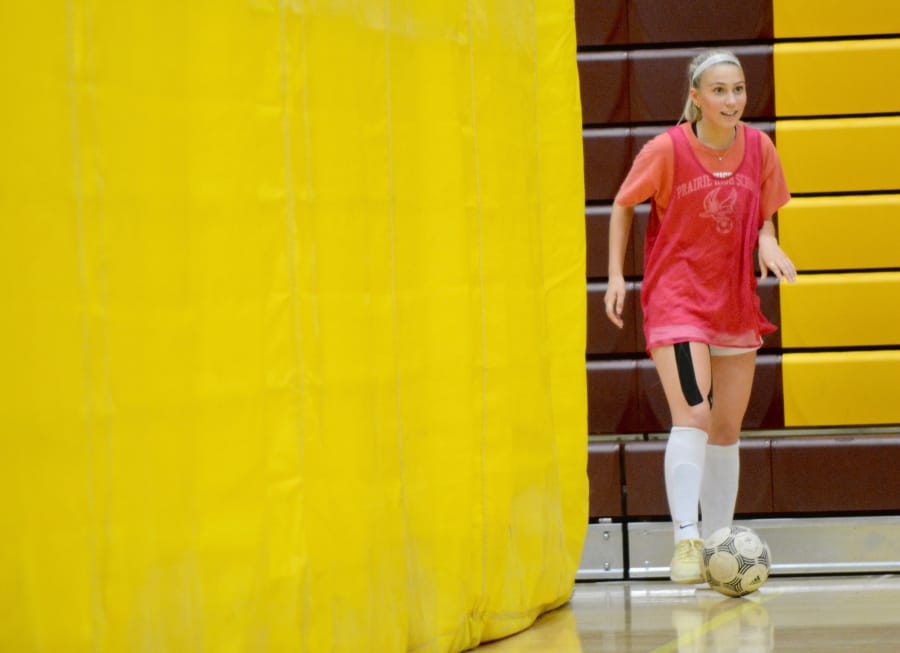BRUSH PRAIRIE — High school soccer is not necessarily synonymous with analytics, but Michael Thyron fancies himself a bit of a data fiend.
He habitually weighs himself every day and tracks his exercise, three lifts per week, and cycling mileage — “the things old men do to stay in shape,” he jokes.
As an upstart soccer coach at Fort Vancouver in 1988, he installed a system that would change the game for his program for decades to come.
Fast forward 30 years, he’s the longest tenured high school soccer coach in Clark County and has implemented a professional-like, data-driven system that has been instrumental in the success of Prairie’s boys and girls soccer programs over the years.
Each player is tested on specific aspects of their fitness and game, then is ranked with a composite score.
For Thyron, who has led three different programs to a top-5 state tournament finish over the course of his career, highlighted by a fourth-place finish with Prairie girls in 2010, it’s a system built to challenge students and demand responsibility.
“When they have to explain to their parents ‘I’m here because I didn’t test very well,’ it’s up to them to work harder and justify their move-up,” Thyron said. “If they put in timed effort they will make movements.
“I’m one of those kinds of people who tries to make everything objective so you’re being as fair and transparent as possible.”
Where other coaches might lean on gut instinct, or more big-group scrimmages to access talent, Thyron does only what he can measure. Prairie’s pool of players are put through a ringer of individual speed and skill tests, and teams are selected using an objective ranking system.
“I don’t think very many high schools are doing this,” said Thyron, who teaches P.E., health and German at Prairie. “In the area, I don’t know of anyone that is doing it.”
The Falcons are able to, in part, due to their sustained turnout.
At tryouts on Monday and Tuesday, a pool of 50 players competed in the 40-yard dash, an intermittent endurance test, a radar gun test and various footwork and one-on-one drills.
Players and team managers tracks each individual result on a charts full of matrices, which create a data set used to determine where each player ranked.
Each team — varsity, junior varsity and C-team — are chosen based on those rankings, one through 50.
Thyron calls his “competitive cauldron.” The system pits players with similar scores against each other in close quarter, one-on-one settings in an effort to maximize personal accountability.
“We’ve discovered that you have to create that cauldron for the girls so they will be willing to compete against each other,” Thyron said. “Everyone’s always competing for a win in a drill.”
Thyron likens the process to taking the SAT, which evaluates knowledge across subjects.
But instead of being in a classroom taking a test on your own, players are pitted against each other in real time. Being ranked among your peers can be a vulnerable experience, proves difficult for some players.
“We’re doing these one-v-ones or two-v-twos someone might have scored low on their dribbling test so you might want to take them one-on-one, or they do well on their fitness and speed you can use that to your ability, but they can also see your strengths and weaknesses too,” senior midfielder Malaika Quigley said.
Thyron sites players who tested onto the C-team roster at tryouts, and by the end of the season, were competing on varsity. Taylor Lawhead, a junior last year on the boys team, is his most recent example.
Most players who stick with the program see improvement as they become accustomed to the system. Junior Haley Reed was challenged to improve her technical skills when she was not scoring as high.
“I had to focus on that more,” Reed said.
Senior captain Savannah Harshbarger likes how the system pushes everyone individually first. But when the team plays its first preseason game, the full-field, 11-a-side play feels a bit foreign.
“Once we start playing our preseason games, we’re like, oh, we actually have to play together now.”
German influence
When Thyron was a senior in high school, he went to Germany to play soccer for the season, touching up his remaining high school credits while abroad.
Born a first generation American to German parents — his mother is from Stuttgart, father from Essen — he grew up a German soccer fanatic.
“They assess everything you do, and that’s where I originally started it,” Thyron said.
He eventually stumbled onto the work of University of North Carolina coach Anson Dorrance, a 21-time NCAA champion who has written books about his keys to success. Much of his system fell in line with what Thyron had already studied.
“Everything they do they try to make it quantifiable, measurable,” Dorrance said. “That’s data they can compare and contrast.”
Like Dorrance, Thyron has shared his system with others. He’s written academic journals and exchanged philosophies with coaches over the years.




